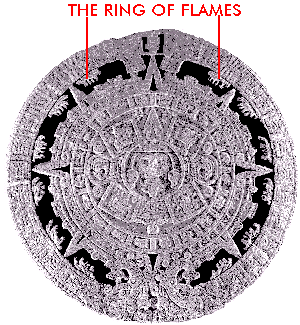THE RING OF FLAMES
Introduction
In our analyses of the Aztec Calendar, La piedra del sol, we have attempted to demonstrate how there are essentially two sets of numbers portrayed in this sculpture. One may possibly identify constant numbers, which represent numerical quantities, which may be employed to make calculations with the event numbers or cycle numbers of reckoning systems of Ancient Mesoamerica. The constant numbers appear to follow multiples of a relation of 20:32, or the 5:8 ratio of the orbits of Venus to Earth. The event numbers refer to the day-counts, the year-counts, the cycles and the calendar rounds regarding these specific forms of reckoning time.
The Ring of Flames seems to represent these two sets of numbers in a similar manner as the other rings; with numbered elements and symbolic elements. The Ring of Flames has also been referred to previously as clouds and rain, although now it is generally accepted that its elements reflect the old/new flames of ancient beliefs, whereby every 52-years a new flame was set bringing in a new era, a new cycle of time. We have shown in previous essays, that the 52-year cycle seems to have been well chosen by the ancient astronomer-priests in that 52 years (of the 365 count) represents 1/500th of the Sun's Great Cycle of 26,000 years (365c). Many scholars are not yet willing to accept that the ancient peoples of Mesoamerica knew and calculated the Sun's Great Cycle, or what is also known as the Precession of the Equinoxes. However, a look at the Ring of Flames may help us understand better the designs within the Aztec Calendar and their possible meaning.
 |
Part One